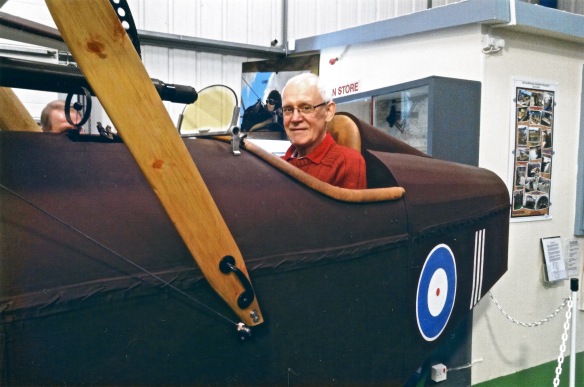Shelley made a brief visit this morning, and Mum, Elizabeth and Jacqueline came for lunch and spent the afternoon with us, largely sharing memories. After an exchange of presents, Jackie provided her excellent watercress soup, samosas, and a vast array of cooked meats and salad. I would like to say this was accompanied by a bottle of Three Choirs Wickham dry white wine that Elizabeth had brought and placed in the fridge. Unfortunately I forgot about it, so we enjoyed it later in the day.

Elizabeth and I scanned a print of a photograph of Chris taken earlier in the year,so that she can send Frances an enlargement. Hopefully we then e-mailed it to her at home where she will make the print. Apart from the poignancy of this being one of the last images of our brother, the cockpit in which he is sitting has significance in family history. On a visit to Tangmere Aircraft Museum, Chris occupies a replica of the SE 5a Scout from 1918. During the latter part of The Great War, our paternal grandfather, John Francis Cecil Knight, trained airmen to fly these planes. From the museum web page we read:
‘SE5A COCKPIT REPLICA
The Royal Aircraft Factory SE 5a scout was one of the most successful British fighter aircraft of the First World War and was one of the first aircraft to fly from the newly created RAF Tangmere in 1918 when No 92 Squadron trained here before leaving for the Western Front. The Museum’s replica was built to mark the centenary of the outbreak of the First World War and constructed by a small team drawn from our engineering staff using original drawings and employing the same techniques that were used for the original aircraft’.

The discussion about the SE 5a Scout led Mum to recount her experience of a beautifully sunny day on 27th May 1930. There had been great disappointment in Manchester on the rainswept 16th December 1929, when the huge airship the R101 was expected to fly above the city. In fact the R101 missed Manchester, but would not have been visible anyway in those weather conditions.
 Seven year old Jean Hunter was, six months later, on that May day, lined up with the rest of the schoolchildren in the playground of the Jewish Board school in Waterloo Road. Mum attended this school because the prison officers’ quarters, to which her father was entitled, was nearby. There was much excitement and dazzling of juvenile eyes peering into the skies. No sound came from above. Mum thinks that had there been any noise they would have been scared.
Seven year old Jean Hunter was, six months later, on that May day, lined up with the rest of the schoolchildren in the playground of the Jewish Board school in Waterloo Road. Mum attended this school because the prison officers’ quarters, to which her father was entitled, was nearby. There was much excitement and dazzling of juvenile eyes peering into the skies. No sound came from above. Mum thinks that had there been any noise they would have been scared.
Suddenly, slowly, silently, a huge sausage shaped balloon glided overhead. This was not the R101, but its sister ship the R100. The Manchester Evening Mail described the transport thus: ‘Imagine an object with an enormous length equal to that of two football pitches, shaped like a massively long and cigar-shaped dart; cruising at almost roof-top height, with its silvery outer-skin gleaming in the May mid-day sun, and moving so slowly it seemed to hover: Well! I put it to you such a sight would stop traffic even now; and to an age hardly used to air-flight, it must have appeared awesome’.
Three days after little Jean’s eighth birthday on 2nd October 1930, the R101, on its maiden passenger flight crashed in France and burst into flames. This effectively ended the British air industry’s airship adventure, and the R100, that had so awed Manchester’s thousands, was dismantled in its shed at Cardington in November 1931 and eventually sold as scrap for £450.